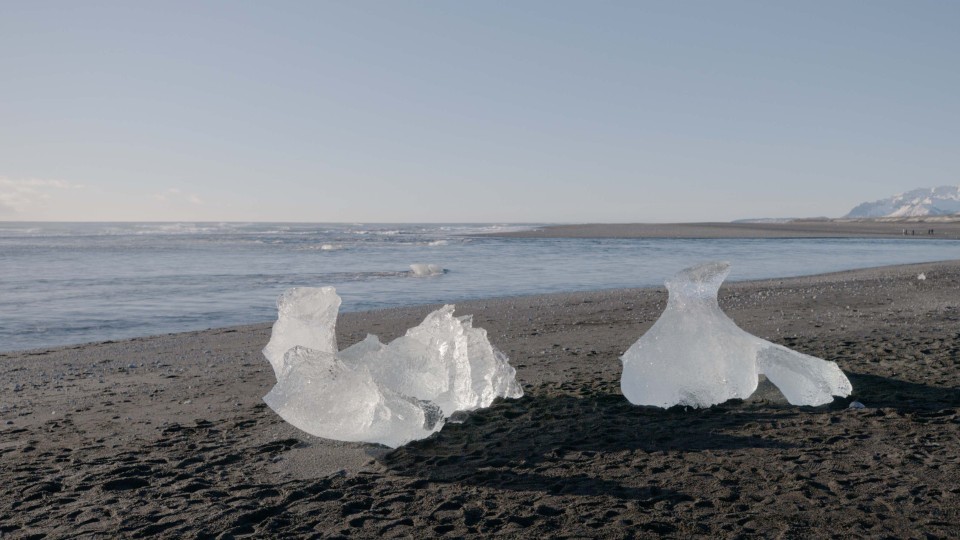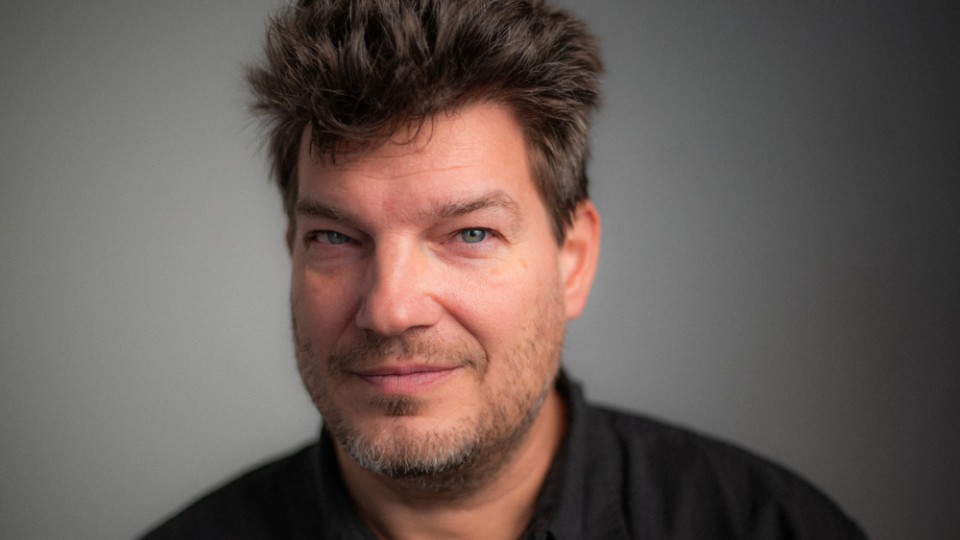Snow is simultaneously quietly magical and an unpredictable force of nature. And whether there’s too much of it or too little,
it presents people with huge challenges. In MELT, Nikolaus Geyrhalter tracks down landscapes of ice and snow which seem unreal and observes at places of solitude as well
as at sites of mass tourism how humans deal with this gradually vanishing feature of our world.
MELT deals with snow and ice. The presence of water in this form, as well as its absence, poses considerable challenges for
human beings. What prompted you to focus on this dwindling natural resource?
NIKOLAUS GEYRHALTER: I like snow. And I especially like snow in movies. I like it when it snows. And ultimately, as so often in my films, MELT
is about people and how they deal with something. Climate change is a major subject, but making a film explicitly about climate
change didn't strike me as very appealing. It's much more interesting to show the situation right now. I see the film as a
way of capturing life with snow, where it still plays a role in everyday existence, and of creating a kind of monument to
frozen water. As always, it’s also a film for future archives.
Isn't a documentary film about current issues always a kind of future memory? Is one key motif of MELT that you film irretrievable
images on a large scale, images that dissolve in front of the camera?
NIKOLAUS GEYRHALTER: Yes, that’s another basic approach which I use in this film. Documentaries are often made with the main aim of having an impact
in the present. I try to shape my films in such a way that they hold a future memory.
Actually, you’re always aware that what you’re filming is transient. We shot in places where the snow won't disappear tomorrow.
But there are slow processes at work. I don't want to reduce MELT to a film about that disappearance. It’s also important
for me to make these snow worlds come alive, and to learn a lot about people in the process. Snow is a challenge for the people
who live with it. It’s usually in the wrong place at the wrong time.
What was it about the places we see that made you want to film there?
NIKOLAUS GEYRHALTER: If you consider snow, at least in the Alpine region, you very soon find yourself addressing the subject of tourism and the
logistics of controlling snow. It was more challenging to find topics that weren’t related to tourism.
Finding locations and obtaining filming permits is always a process of hunting and gathering, right up to the end; it might
be the hardest task of all. You carry on researching while you’re shooting; it's always a response to what's happening in
the world at that moment. The long production time was an advantage in that for two of the locations – in Japan and Antarctica
– obtaining filming permission was a very long, complex process. After years of preparation, we were only able to proceed
with those two important shoots at the very end.
Earth (2019), Matter out of Place (2022) and MELT are three films where you depict our planet being transformed fundamentally by the extensive use of machines.
What prompts you to concentrate on the interaction between man and machine in the natural world?
NIKOLAUS GEYRHALTER: It only became apparent to me how much machines would also feature in this film while we were shooting. The theme was ice
and snow, and I was sometimes surprised to encounter so many diggers again. At first, I myself probably harbored a romantic
notion of man and snow which hardly exists anymore. That’s appropriate for the film. Machines say a lot about us humans. A
digger does what it’s supposed to do, without thinking; it doesn’t stop until it breaks down. That's how we are. We basically
don't want to be restricted. If something needs to be moved, we move it, building bigger and bigger machines to do so. I felt
it was important to show that all this consumes a lot of resources.
You always seem to look at machines like diggers as if they were somehow like living beings ...
NIKOLAUS GEYRHALTER: I like machines, and I also like to film them, because I understand the attitude of the people who control them. They’d never
before issued a filming permit for the construction of the snow corridor in Toyama, because it was felt that letting people
move around there was far too dangerous. But I really wanted to shoot there, because I was convinced that it would be the
ultimate image for this film of how machines are deployed. When we met with the team there, and I assured them that I could
operate machines like that myself – so I could evaluate the situation properly – it immediately inspired confidence. We were
in radio contact with the drivers and were able to get very close to the machines in the end. I always feel very comfortable
in places where the action is predictable. I can work well in settings like that.
How did you approach the beauty and purity that a snowy landscape offers?
NIKOLAUS GEYRHALTER: By trying to find appropriate images for it. Beauty can be depicted "beautifully". The decisive factor is what function the
images have. Basically, one reason you go to the cinema is to have an aesthetic experience. That’s connected with the images,
the three-dimensional sound and, of course, the time allowed for the images to breathe. It’s important that "beautiful" pictures
should do more than just be beautiful.
Were there moments when you were overwhelmed by something you saw?
NIKOLAUS GEYRHALTER: The idea of being overwhelmed in this line of work is usually an illusion. It just doesn’t happen. Because of the research,
you know where you're going and what to expect. You’ve made the preparations, and you try to make the best of it. While I’m
shooting, I don’t actually feel very present myself, because I function like a machine. I know I have a week, and at the end
of that time the job has to be finished. For example, I don't take many personal photos on shoots; I live to do the work,
and all my energy goes into capturing the shots and the composition that I'm constantly looking for. But I really can say
that we were very overwhelmed by Antarctica. When we arrived, everything was still frozen. Then the weather got warmer, there
was a snowstorm, the bay thawed out, and the ice floes with penguins drifted away – it was unreal and moving. Unfortunately,
Antarctica is another place where tourism has begun and will also get out of hand. That feels very wrong.
The snowy landscape not only provides powerful images for films; it also serves a tourist memory industry. The creation of
memories, which is one of your themes, is also a recurring motif in MELT, with tourists taking selfies, showing what is done
to nature in order to create beautiful memories.
NIKOLAUS GEYRHALTER: Industry really is the right word here. Nature has to function in this context; it provides the backdrop but has no say in
what takes place. The number of snow cannons in Val d'Isère per kilometer of slopes gave me a lot to think about. This upmarket
resort, which is actually at a very high altitude, must use any means necessary to provide quality discreetly. People have
to be offered an experience.
However, I don't show the après-ski party in the mountains to make a criticism. I'm not so strict any more about what I think
is good or bad; I don't have such a moral viewpoint about details like that. It's wrong to start a war, but dancing to loud
music in the mountains probably isn’t wrong. I regard that sequence as a tongue-in-cheek look at our society, without passing
judgement. I am not entitled to do that.
The last episode, at the Neumayer Station, takes on the function of an epilogue. Can you describe that place?
NIKOLAUS GEYRHALTER: The Neumayer Station is a German research facility in Antarctica, one of the largest there. It’s manned all year round by
a team of about nine scientists and technicians who have to keep it in good shape. There is a lot going on there in the Antarctic
summer, when they perform scientific experiments and do maintenance work. We were there during that period. As soon as it
gets dark at the end of the Antarctic summer – which means no sunshine for the next three months – it becomes very quiet there.
You can reach the station from Cape Town; it’s a six-hour flight in a large plane and another two hours in a smaller one with
skis. But in winter, the plane can’t land there. You can't get in or out; nothing can happen.
Is it an almost utopian place?
NIKOLAUS GEYTHALTER: Where the station is located, there is an endless flat expanse on one side, and the open sea not far away on the other. Many
people who have been there want to go back. Life there can be quite addictive, because there’s something unreal about it.
All the problems we have here seem very far away and unimportant. And it’s a place where everyone has to rely on each other.
There has to be a stronger sense of community, otherwise it wouldn't work.
But even this pure, concentrated landscape is beginning to dissolve. You have seen a huge number of extreme places in your
film work and are probably in a better position to form a global picture of our planet than all but a very few other people.
What is your conclusion?
NIKOLAUS GEYRHALTER: I think about that a lot. At the end of the film, Jölund says those people who understand the state of our planet have a
responsibility to act. I am one of these people, no doubt about it. Through my work, I have experienced the happiness of being
human, but far more often I’ve seen the abysses and cruelties of our existence in so many facets and forms. No species harms
our planet as much as we do. And I can't use the excuse of ignorance. Unfortunately, that doesn't necessarily make me a better
person who tries to do everything right. Living a life that doesn't do too much damage should be the aim. In everyday life,
that’s quite a challenge. So my conclusion isn’t a simple one. I like every digger driver, every person who operates a snow
cannon or who dances around yelling after a day’s skiing. As soon as you enter into a dialogue with them, understanding works
on a small, personal level. The system behind it is frightening. The system of humankind isn’t working. As a species, it’s
impossible to like us. And I think that's where we're failing right now: the really personal encounters, I mean those that
aren't filtered through screens, are becoming fewer and fewer.
Interview: Karin Schiefer
September 2025
Translation: Charles Osborne








